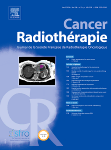
Publication date: Available online 10 August 2016
Source:Cancer/Radiothérapie
Author(s): C. Hennequin, I. Barillot, D. Azria, Y. Belkacémi, M. Bollet, B. Chauvet, D. Cowen, B. Cutuli, A. Fourquet, J.M. Hannoun-Lévi, M. Leblanc, M.A. Mahé
Dans le cancer du sein, la radiothérapie est un élément essentiel de la prise en charge. Après traitement conservateur pour un carcinome infiltrant, l'irradiation complémentaire doit être systématique, quelles que soient les caractéristiques de la patiente, car elle diminue le taux de rechute locale et améliore par-là la survie. L'irradiation partielle n'est pas une technique de routine mais peut être proposée à des patientes sélectionnées et dûment informées. Pour les carcinomes canalaires in situ, l'irradiation doit également être systématique après tumorectomie. Après mastectomie, une irradiation pariétale complémentaire s'impose pour les patientes atteintes d'une tumeur classée pT3–T4, envahissant ou non les ganglions, quel que soit le nombre de ganglions atteints. Après chimiothérapie néo-adjuvante et mastectomie, et en l'absence d'atteinte ganglionnaire durant l'intervention, l'irradiation est préconisée s'il existait une lésion classée T3–T4 ou une atteinte ganglionnaire clinique ou radiologique avant la chimiothérapie. L'irradiation axillaire n'est, la plupart du temps, pas indiquée après curage chirurgical ; elle se discute en cas de ganglion sentinelle atteint et en l'absence de curage. L'irradiation des aires sus- et sous-claviculaires est préconisée en cas d'atteinte histologique axillaire. L'irradiation mammaire interne se discute au cas par cas, en évaluant le rapport bénéfice-risque (toxicité cardiaque). Une dose de 45–50 Gy est délivrée dans la totalité du sein en fractionnement classique. Un complément de dose (boost) dans le lit tumoral doit être délivré chez les patientes de moins de 60ans après traitement conservateur. Des modalités d'hypofractionnement sont possibles après tumorectomie, si les aires ganglionnaires ne nécessitent pas d'irradiation (42,5 Gy en 16 fractions, ou 41,6 Gy en 13 ou 40 Gy en 15). La délinéation du sein, de la paroi et des aires ganglionnaires repose à la fois sur des données cliniques et radiologiques. La technique usuelle reste l'irradiation conformationnelle tridimensionnelle, la radiothérapie en modulation d'intensité n'ayant que des indications limitées. L'asservissement respiratoire pourrait être utile en cas de dose reçue par le cœur excessive. L'administration concomitante de la chimiothérapie adjuvante est déconseillée. En revanche, l'hormonothérapie peut être débutée en même temps que l'irradiation.In breast cancer, radiotherapy is an essential component of the treatment. After conservative surgery for an infiltrating carcinoma, radiotherapy must be systematically performed, regardless of the characteristics of the disease, because it decreases the rate of local recurrence and by this way, specific mortality. Partial breast irradiation could not be proposed routinely but only in very selected and informed patients. For ductal carcinoma in situ, adjuvant radiotherapy must be also systematically performed after lumpectomy. After mastectomy, chest wall irradiation is required for pT3–T4 tumours and if there is an axillary nodal involvement, whatever the number of involved lymph nodes. After neo-adjuvant chemotherapy and mastectomy, in case of pN0 disease, chest wall irradiation is recommended if there is a clinically or radiologically T3–T4 or node positive disease before chemotherapy. Axillary irradiation is recommended only if there is no axillary surgical dissection and a positive sentinel lymph node. Supra and infra-clavicular irradiation is advised in case of positive axillary nodes. Internal mammary irradiation must be discussed case by case, according to the benefit/risk ratio (cardiac toxicity). Dose to the chest wall or the breast must be between 45–50Gy with a conventional fractionation. A boost dose over the tumour bed is required if the patient is younger than 60 years old. Hypofractionation (42.5 Gy in 16 fractions, or 41.6 Gy en 13 or 40 Gy en 15) is possible after tumorectomy and if a nodal irradiation is not mandatory. Delineation of the breast, the chest wall and the nodal areas are based on clinical and radiological evaluations. 3D-conformal irradiation is the recommended technique, intensity-modulated radiotherapy must be proposed only in case of specific clinical situations. Respiratory gating could be useful to decrease the cardiac dose. Concomitant administration of chemotherapy in unadvised, but hormonal treatment could be start with radiotherapy.
from Cancer via ola Kala on Inoreader http://ift.tt/2bb2ASN
via
IFTTT
